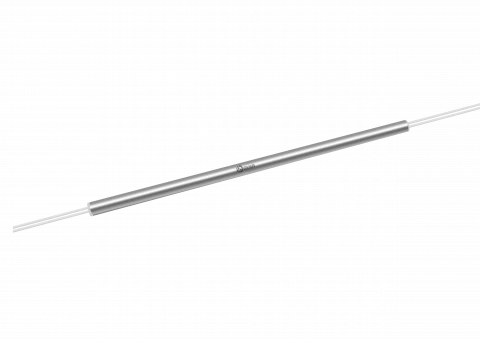Description
The GKER Photonics GK-PMWDM Series is a state-of-the-art Polarization Maintaining Fused Wavelength Division Multiplexer designed for high-performance optical applications. This multiplexer is engineered to combine or separate light at different wavelengths with exceptional precision. It operates effectively at longer wavelengths around 2000 nm and 1570 nm, delivering reliable performance in various optical communication systems. The device boasts very low insertion loss and high extinction ratio, ensuring minimal signal degradation and optimal signal integrity.
The GK-PMWDM Series features excellent environmental stability, making it suitable for diverse operating conditions. It is particularly valued for its high isolation and minimal directivity, which enhance signal quality and system reliability. The multiplexer is compatible with PM 1550 Panda fiber and can handle up to 300 mW of continuous optical power. It operates efficiently over a wide temperature range, from -5°C to +70°C, and is built to withstand storage temperatures as low as -40°C and as high as +85°C. Its rugged design and high-performance specifications make it an ideal choice for advanced fiber optic systems and applications.
2 µm Polarization Maintaining Fused Wavelength Division Multiplexer
Specifications
| Operating Wavelength: | 2000 nm |
|---|---|
| Operating Bandwidth: | Not Specified |
| Isolation (min): | 15 dB |
| Max Power Handling: | 300 W |
| Polarization Maintaining: | Yes |
| Longer Operating Wavelength: | 2000 ± 20, or specified nm |
| Max. Insertion Loss: | 0.7 dB |
| Min. Isolation: | 13 dB |
| Min. Extinction Ratio: | 20 dB |
| Shorter Operating Wavelength: | 1570 ± 20 800± 20 650 ± 20 nm |
| Max. Insertion Loss: | 0.7 0.7 1.5 dB |
| Min. Isolation: | 15 15 10 dB |
| Thermal Stability: | ≤ 0.005 dB/℃ |
| Min. Return Loss: | 55 dB |
| Min. Directivity: | 55 dB |
| Max. Optical Power (Continuous Wave): | 300 mW |
| Fiber Type: | PM 1550 Panda fiber - |
| Operating Temperature: | - 5 to + 70 ℃ |
| Storage Temperature: | - 40 to + 85 ℃ |
Features
- Low Insertion Loss: Minimizes signal loss with a maximum of 0.7 dB at the operating wavelength
- High Extinction Ratio: Maintains superior polarization performance with a minimum extinction ratio of 20 dB
- Excellent Environmental Stability: Operates reliably in challenging environments with thermal stability ≤ 0.005 dB/°C
- High Isolation: Provides effective wavelength separation with a minimum isolation of 15 dB
- Versatile Wavelength Options: Supports multiple wavelengths including 2000 nm, 1570 nm, 800 nm, and 650 nm
Applications
- Fiber Laser Systems: Ensures precise wavelength management and polarization control in fiber laser applications
- Optical Amplifiers: Enhances signal integrity by maintaining polarization and minimizing insertion loss in optical amplification setups
- Wavelength Division Multiplexing (WDM) Systems: Provides reliable wavelength separation and combination, crucial for complex WDM networks
- Optical Communications: Delivers high performance in optical communication systems where polarization maintaining, and wavelength division are critical
- Biomedical Sensing: Ideal for sensitive biomedical applications requiring stable and accurate wavelength division
Frequently Asked Questions
What is the maximum insertion loss of the multiplexer?
What is the minimum extinction ratio provided?
What are the operating wavelengths of this multiplexer?
What is the maximum optical power it can handle?
What is the operating temperature range?
What type of fiber is used in this multiplexer?
What is the minimum return loss?
How stable is the device in varying temperatures?
What is the maximum directivity of the multiplexer?
What are the package dimensions of the multiplexer?
Similar Products












Your inquiry has been received.
Create an account by adding a password
Why create an account?
- Auto-complete inquiry forms
- View and manage all your past messages
- Save products to your favorites
- Close your account anytime — no hassle
